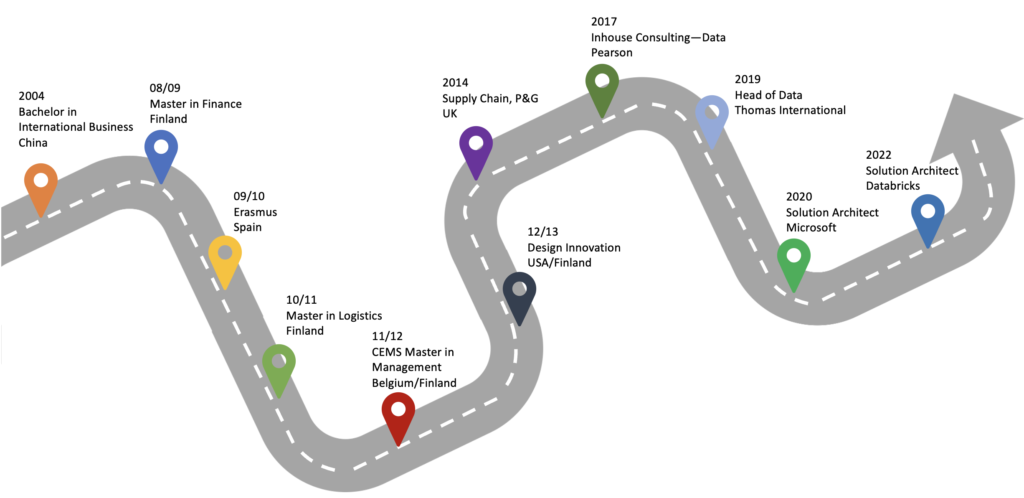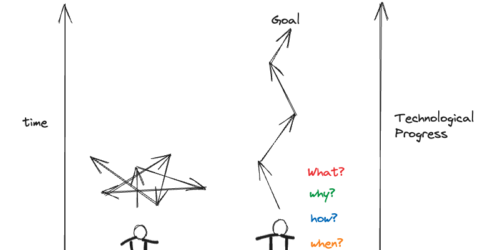Getting into technical Data & AI roles from a Non-STEM background

Recently I had some time to reflect on my academic and professional career. Having done multiple degrees that are not STEM related and started my career working for P&G in supply chain a decade ago, it feels incredible that I am working in Data and AI as a solution architect today. Over the years, I have also coached several graduates and early-in-careers (coming from backgrounds ranging from history to phycology) getting into technical Data & AI roles, I decided to write down my learnings in the hope that it would be helpful for someone else.
First Things First
This is hard work.
Compared to people who come from STEM background, it would harder for you to build up skills/knowledge, to leverage your professional network, and to prove yourself to the potential employers. It takes a LOT of work to get in and a LOT of work to keep up. If you are not prepared to put in the work, it is better to choose another career path. That said,
Everyone who wanted to get in, got in.
I don’t have a huge data sample, but everyone I coached, some of my colleagues, myself, everyone that I know of that wanted to be in a technical Data and AI role, got in. Nobody arrived at where they are today without putting in decent amount of work. However, if you are willing to work hard, there will be a seat for you.
Before you switch
Know who you are (not)
Not everyone knows who they are. But you will know (in your gut) who you are not and that you are in the wrong job. I was unhappy when I was doing supply chain at P&G, while this is perfectly fine job and perfectly good company, for someone else. Back then, I didn’t know what I wanted to do, but I knew firefighting and Excel was not it. If you know you are in the wrong role, do something about it. Think about what type of work makes you happy and excited. If the conclusion is that you are insatiably curious and love problem-solving using data, Data & AI might be a good fit for you.
Do it for the right reasons.
Do it because it would be a good fit for you, not because chatGPT is popping up everywhere. Do it because you have a genuine interest in this industry, not because every company is recruiting for a data scientist or AI engineer. Do it because you love it, not because it’s the new shiny buzzword. Do it for the right reason, otherwise it’s unlikely to last.
Preparation
What you do in your spare time matters.
If you are from a non-STEM background and doing a non-technical job, and you spend all your spare time on Netflix, Tiktok, pubs or clubs. The door to technical roles will not automatically open for you. Equally, if you work a 100-hr week in your current non-technical job, it is unlikely you will have enough capability to do the learning and upskilling needed. Back to the point of “hard work”, you must put in the work, in your spare time.
Get the basics right, SQL & Python.
There is a lot to learn and a lot more ways to learn vs 10 years ago. Different cloud providers, venders, certificates, nano degrees and learning paths can be overwhelming. My personal view is to get the basics right. Regardless of what role you are going for, learn SQL and Python. From there, you can pick up additional programming languages, domain knowledge and cloud specifics based on your aspiration.
Broaden your horizon.
Don’t limit yourself to the roles you come to know first. There are so many different roles in Data & AI, and new roles are being invented as the industry is evolving at lightening speed. A few years ago, everyone wants to be a data scientist, right now everyone wants to be a prompt engineer. The roles you come to know first might not be the right role for you. What’s popular right this moment might not be the right role for you. Do you research and understand what roles there are and what these roles are like. Back to the point of “Knowing who you are”, map these roles to what makes you tick. For your long-term happiness at work, it’s worthwhile to do some homework upfront.
Eyes on the prize.
There are a lot of noises these days. It’s very easy to get distracted. After doing your research and knowing what you want, make a learning plan, execute it in your spare time and work towards your goal. Trust your research, you set the goal for a reason. It’s not wrong to pivot your goal, but it is wrong to pivot your goal without proper research.
Learn from the best.
There is a lot of different ways to learn. I found the most efficient way to learn is to learn from the best. If I want to learn about MLOps, I find the best specialist I can find and have them do a brain dump on me on the subject. This approach does not work if you have not “gotten the basics right”. If you know nothing about ML and DevOps, that brain dump of MLOps will sound like German to you. However, having covered the basics, that brain dump will give you the most concentrated and essential knowledge you need to have on that subject and help you identify the gaps in your knowledge and where to focus on. For me, it works a lot better than doing an online course for hours and hours.
Get your hands dirty, there is no other way.
Code, play with the product, learn by doing. There is no other way. Tech is like language. If you don’t use it, you will forget it. Therefore, roll up your sleeves, get your hands dirty is the best way.
Get a sounding board.
Your own view of how much you have progressed can be skewed if you don’t have a sounding board. Get a study buddy/mentor, collect feedback from them and incorporate their feedback into your plan.
Let your work speak for itself.
Having “gotten your hands dirty”, now you have an advantage. You can let your work speak for itself. Set up a github account, include your github link in your resume and let your code do the talking. Your code might not get checked by the interviewer. However, if you are competing with someone else for the same role, a good github repo might help you stand out.
During Job Hunting
All you need is ONE yes.
Given you come from a non-STEM background, you will likely get a lot of Nos. Do not be discouraged. All you need is ONE yes. I had a lot of Nos too when I first started out because I was looking for a job in Finland and my Finnish was not good enough in a business setting. After being turned down by about 50 companies, I had the ONE yes that I needed. DO NOT GIVE UP.
Nothing you do is ever wasted, use your domain knowledge.
Regardless of where you come from, nothing you ever do is ever wasted. I came from supply chain background, now I can use supply chain terminology that I am familiar to speak to head of supply chain and help them implement supply chain specific Data & AI solution. If you come from psychology background, you can try finding a Data & AI technical role in a psychometric company. You do not have to throw away what you already know, you can use your domain knowledge to get into Data & AI.
Be honest about what you know, on paper and in interviews.
Having done a range of different roles in data, ranging from Head of Data to Solution Architect, I interview a least a few hundred people, if not more. One advice I would give to anyone is DO NOT LIE in your resume or in interviews. Some people like to put buzz words in the resume. If I ask you about something in your resume, and you cannot explain the basics, all I will be wondering about is what else is not true on your resume. Same with the interviews, if I ask you the question, I know the answer. Try not to throw something at the wall and hope it sticks.
After you get in
Keep learning, never stop.
Congratulations, now you are in. Remember that it is a pitstop, not the checkered flag. We all know how fast the industry is evolving, if you do not keep up, you will be left behind.
Pay it forward.
If you can.
On average it took me 30 mins monthly to coach someone and it took between 6-12 months before they get a technical job in Data & AI. This blog took me about 2 hours to write. So if 1 person is successfully benefited from this blog, I have exceeded my average ROI. Let me know how you get on.
Discover more from Data Leaps
Subscribe to get the latest posts sent to your email.






